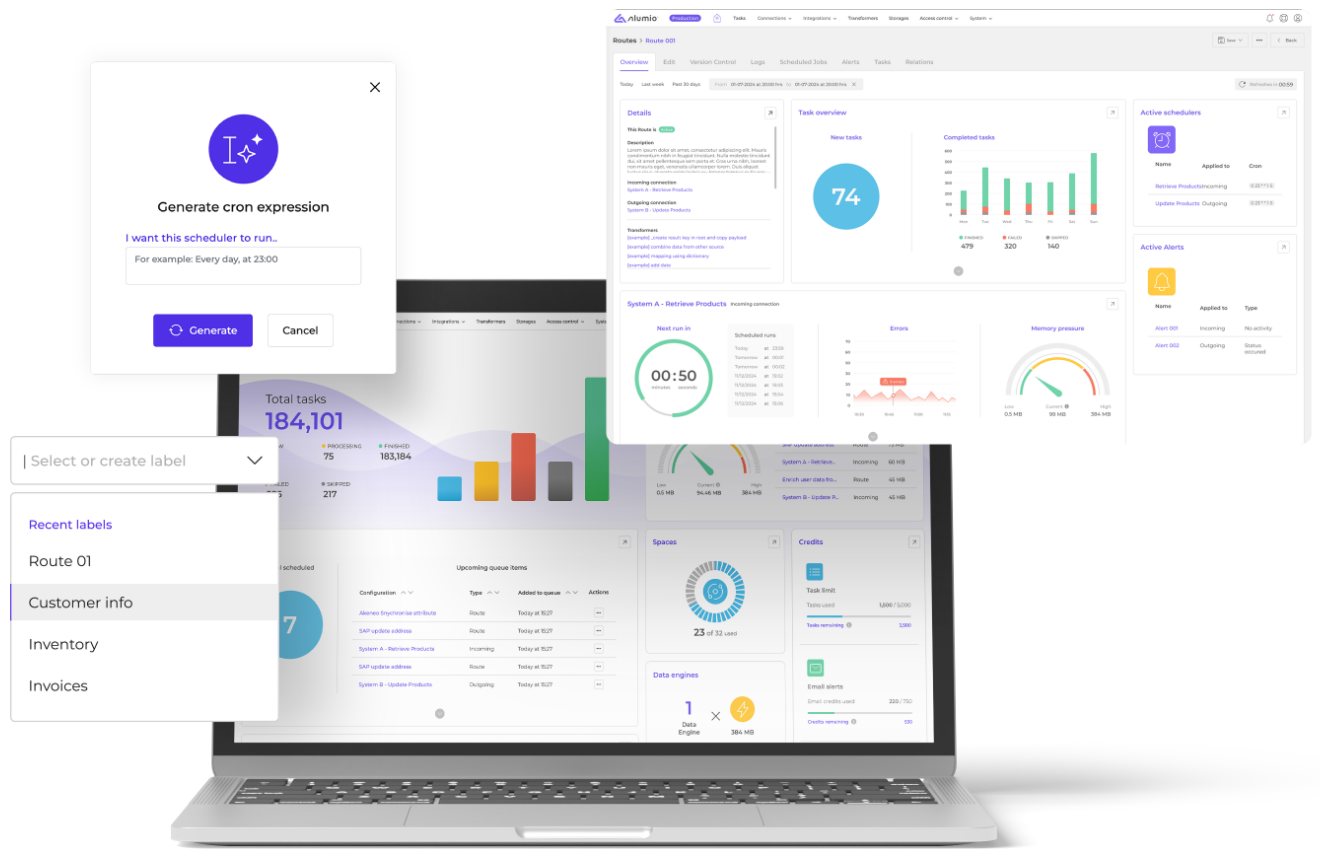Hinder för affärsinnovation som en iPaaS hjälper till att övervinna
IT populära undersöknings- och konsultföretaget Gartner presenterar en "Hype Cycle" som ett verktyg för att identifiera överlappande stadier i en tekniks livscykel. Det femte steget i denna Hype Cycle kallas "Plateaus of Productivity" och it uppnås när en ny teknik är allmänt implementerad, accepterad och förstådd.
När it gäller molnbaserade integrationstjänster förutspår Gartner att produktivitetshöjningen kommer att slå igenom fullt ut inom de närmaste två åren. Detta innebär att företag integrerar sina affärssystem med molnapplikationer, mjukvarulösningar eller datakällor för att digitalisera sina affärsprocesser. Men för att skapa dessa integrationer ser moderna företag nu förbi traditionella metoder med anpassad kod och använder integrationsplattformar low-code även kända som iPaaS (integrationsplattform som tjänst).
"Företagens ökande intresse för självbetjäning inom teknik leder till en snabb tillväxt och ökad mognad för plattformstekniker med low-code "
Gartner, augusti 2022
Upptäck två vanliga hinder för affärsinnovation som Alumio iPaaS hjälper till att övervinna genom att stödja företag med sina molnintegrationstjänster.
Balans mellan budget och behov av processautomation
Numera fokuserar moderna digitala företag inte bara på att förbättra kundanskaffning och kundnöjdhet utan också på kostnadsminskningar. Coronakrisen har lett till att fler och fler organisationer ser sina avdelningsbudgetar skäras ned. Dessutom driver de nya hybrida arbetskraftsmodellerna på företagen att underlätta den teknik som krävs. Sedan finns det teknik för automatisering av affärsprocesser som organisationer vill använda för att öka den totala produktiviteten.
"Verkligheten med en störd arbetsplats, omvandlingar av affärsmodeller, förändringar av verksamhetsmodeller och förändringar av IT tvingar alla fram grundläggande förändringar av aktiviteterna och ansvarsområdena i den givna rollen som CIO." (Gartner, 30 augusti 2022)
Verkligheten är att digital transformation och automatisering av affärsprocesser har blivit den nya normen, och de affärsfördelar som de medför talar för sig själva. Många organisationer och avdelningar har dock begränsade budgetar, vilket är ett hinder som moderna digitala företag måste övervinna för att kunna lägga till eller integrera ny teknik. Som Gartner förutspått stagnerar inte ökningen av automatisering och digitala transformationsverktyg, utan snarare ökar den.
Ökade tekniska krav möter brist på IT
I takt med att allt fler organisationer befinner sig på sin resa mot digital transformation upptäcker de behovet av att integrera molnapplikationer eller SaaS . Detta kräver ofta att man integrerar äldre applikationer och gamla ERP-system med moderna, molnbaserade, kundinriktade applikationer. Det traditionella sättet att integrera dessa applikationer och programvarulösningar innebär dock att man skapar punkt-till-punkt-anslutningar med anpassad kod. För att skapa eller hantera dessa specialkodade anslutningar krävs högt specialiserad IT . Många digitala företag har därför behov av att stärka sin IT för att nå sina mål för den digitala transformationen. Samtidigt uppstår en brist på IT , vilket gör att hanteringen av IT blir allt viktigare.
"Tjugoåtta procent av respondenterna angav bristen på IT som en stor utmaning, vilket hämmar införandet av stora teknikområden som plattformstjänster, säkerhet, digital arbetsplats och IT ." (Gartner, mars 2022)
Genom att kombinera de ökande behoven av integration av ny teknik med den minskade tillgången på IT och nedskurna budgetar står moderna digitala företag inför allvarliga hinder utan något slut i sikte. Detta leder oss återigen till iPaaS. Som en molnbaserad integrationsteknik med självbetjäning gör SaaS det möjligt för organisationer att snabbt ansluta SaaS till nyare applikationer, samtidigt som det möjliggör snabb automatisering av affärsprocesser.
iPaaS - en perfekt lösning för snabb integration av flera applikationer
Alumio iPaaS är en low-code som snabbt kopplar samman två eller flera system, programvaror eller datakällor. Tack vare sin användarvänlighet kan Alumio iPaaS användas av andra än utvecklare, t.ex. dataexperter och affärsanvändare, vilket gör det möjligt för organisationer att använda sina inhemska IT optimalt.
Medan andra nya IT tar mellan 6 och 12 månader att sätta upp, implementeras Alumio iPaaS på 1 till 6 veckor, beroende på hur komplex integrationen är. Det innebär inte bara att integrationsprojekt kan genomföras snabbare än tidigare, utan också att it krävs mindre IT för att utveckla och styra dessa integrationer. Att använda Alumio iPaaS hjälper således företag att minska anställningskostnaderna och optimera hur de använder befintliga IT .
"Organisationer väljer iPaaS för att stödja snabb integration och automatisering av SaaS med andra SaaS och lokala applikationer och datakällor. På senare tid ersätter organisationer i allt högre grad klassiska integrationsplattformar, som nu anses vara för dyra och komplexa för moderna integrationsleveransmetoder." (Gartner, augusti 2022)
Dessutom fungerar Alumio iPaaS som ett framtidssäkert IT som tillgodoser både nuvarande och framtida integrationsbehov. Till skillnad från traditionella integrationslösningar som innebär skräddarsydda integrationer, låser Alumio iPaaS upp datasilos och säkerställer en obruten, fungerande applikationsanslutning. Plattformen erbjuder också ett brett urval av connector-paket som i huvudsak är mallar för populära mjukvaruintegrationer. Med hjälp av dessa kan företag konfigurera fungerande integrationer ännu snabbare och enklare.
Detta gör iPaaS till den perfekta integrationslösningen för moderna, framtidsinriktade företag. It erbjuder de tekniska möjligheter som krävs för digital omvandling och automatisering av affärsprocesser, möjliggör praktiskt taget obegränsade programvaruintegrationer, kräver mindre tekniskt kunnig personal för att driva it och genom att påskynda integrationerna hjälper it företag att uppnå snabbare time-to-market.
"År 2024 kommer 40 % av CIO:erna att misslyckas med att effektivt utveckla ITs förmåga att leverera moderna digitala infrastrukturer, tillhandahålla ekosystemteknikstyrning och stödja arkitekturdrivna affärsresultat. " (Forbes)
Låt inte ditt företag bli en del av denna statistik, boka en demo Alumio iPaaS och upplev själv hur it hjälper till att göra dina programvaruintegrationer enkla.


























